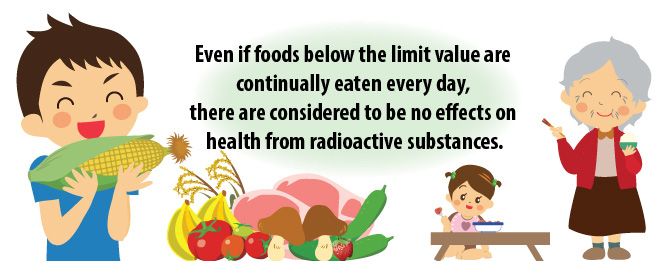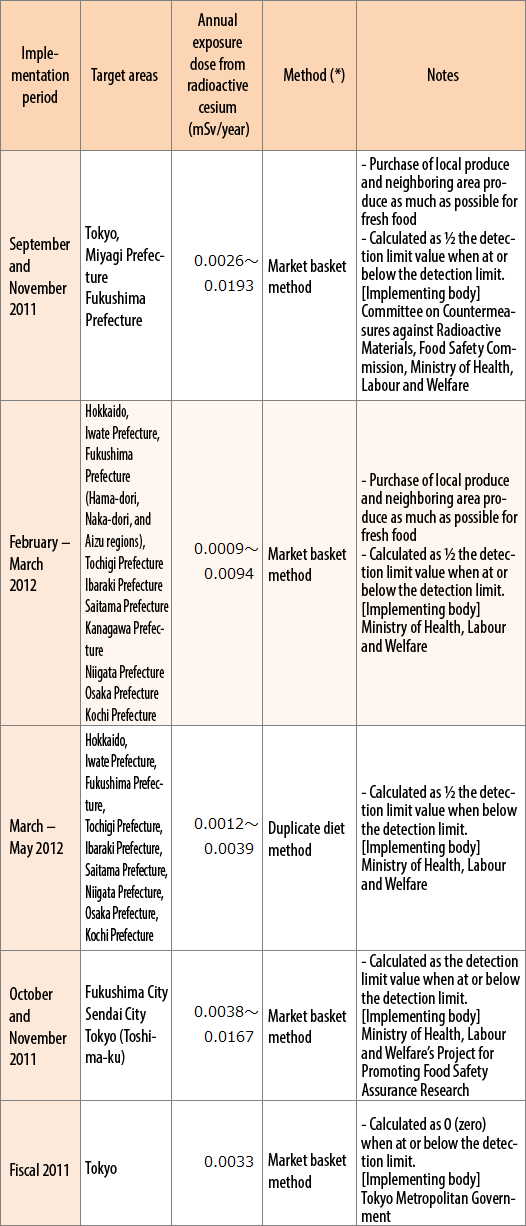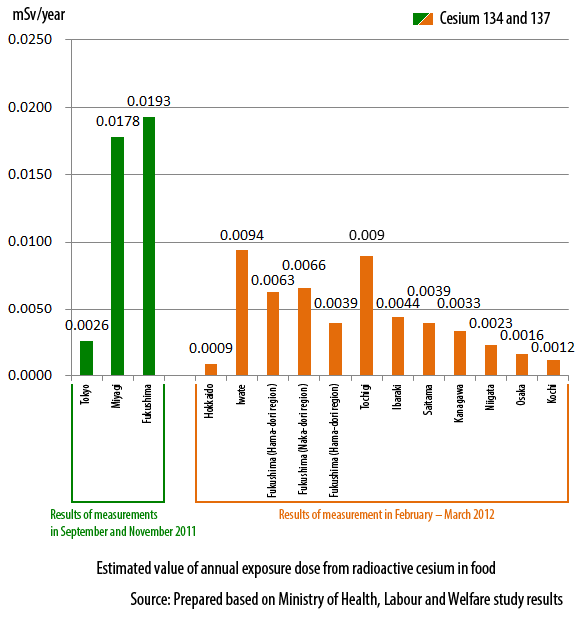Tokyo Food Safety Information Center » Tokyo Metropolitan Government food safety FAQ »Are there any health effects from continuing to eat foods in which radioactive substances that do not exceed the limit values have been detected as a result of testing?
Are there any health effects from continuing to eat foods in which radioactive substances that do not exceed the limit values have been detected as a result of testing?

Are there any health effects from continuing to eat foods in which radioactive substances that do not exceed the limit values have been detected as a result of testing?
- Were there radioactive substances in food before the Fukushima Prefecture nuclear power station accident?
- What does the exposure does amount to if you keep eating?

The limit values for radioactive substances in food are determined to ensure that the lifetime effect from radioactive substances in food is sufficiently small and at a safe level even if people of all ages, including children, continue to eat food that contains the limit value every day.
Therefore, even if foods below the limit value are continually eaten every day, there are considered to be no effects on health from radioactive substances.


Natural radioactive substances were present in food before the Fukushima accident occurred. The most common of these is potassium (40K) as well as polonium (210Po) and others. The annual exposure dose from these natural radioactive substances present in food is about 1mSv. The limit value for radioactive substances in food are determined to ensure that the annual exposure dose due to new, additional radioactive substances from the accident that are separate from natural radioactive substances is kept below 1mSv.
The Codex Committee, which sets international food standards, has determined the international standard for the exposure dose from food contaminated by radioactive substances due to nuclear accidents to ensure that it is no more than 1mSv per year, which is considered to have no effects on health.
The “committed effective dose” is used in the calculation of the exposure dose.
Radioactive substances that are taken into the body break down over time and are metabolized in the body and excreted in urine and feces, thus decreasing. The “committed effective dose” calculates the impact of the radioactive substances that remain in the body cumulatively over 50 years for adults and 70 years for children as the exposure dose received over one year.
In September and November 2011, the Ministry of Health, Labour and Welfare purchased food actually being distributed for sale in metropolitan Tokyo, Miyagi Prefecture and Fukushima Prefecture, measured how much radioactive substances it contained, and estimated the exposure dose for when the food is continually eaten for a year (the market basket method). This showed that the exposure dose from radioactive cesium is lower that 1mSv per year at 0.0026mSv in metropolitan Tokyo, 0.0178mSv in Miyagi Prefecture, and 0.0193mSv in Fukushima Prefecture.
In February – March 2012, the Ministry of Health, Labour and Welfare conducted the same study in 12 areas across Japan, including Fukushima Prefecture and Kanagawa Prefecture. As a result, the exposure dose from radioactive cesium in food ranged from 0.0009 – 0.0094mSv, which was lower than the estimated values in 2011.


In addition, when the Ministry of Health, Labour and Welfare similarly collected a day’s worth of the actual food in ordinary households (duplicate diet method) in nine areas around Japan, including Fukushima Prefecture and Kanagawa Prefecture, to measure it in March – May 2012, the exposure dose from radioactive cesium in food was 0.0012 – 0.0039 mSv.
Apart from this, surveys are also being conducted through the Ministry of Health, Labour and Welfare’s Project for Promoting Food Safety Assurance Research and the Tokyo Metropolitan Government. Please refer to the table below and the website for details.
Table: Results of Studies into Annual Exposure Dose from Radioactive Cesium in Food
*Methods
Market basket method
A method that involves purchasing food distributed for sale to mix and measure 14 food groups including rice and rice processed foods, beans, and fruit, etc. based on intakes by region and food.
Duplicate diet method
A method that involves collecting one day’s worth of food for a specific individual from an ordinary household to mix and measure.